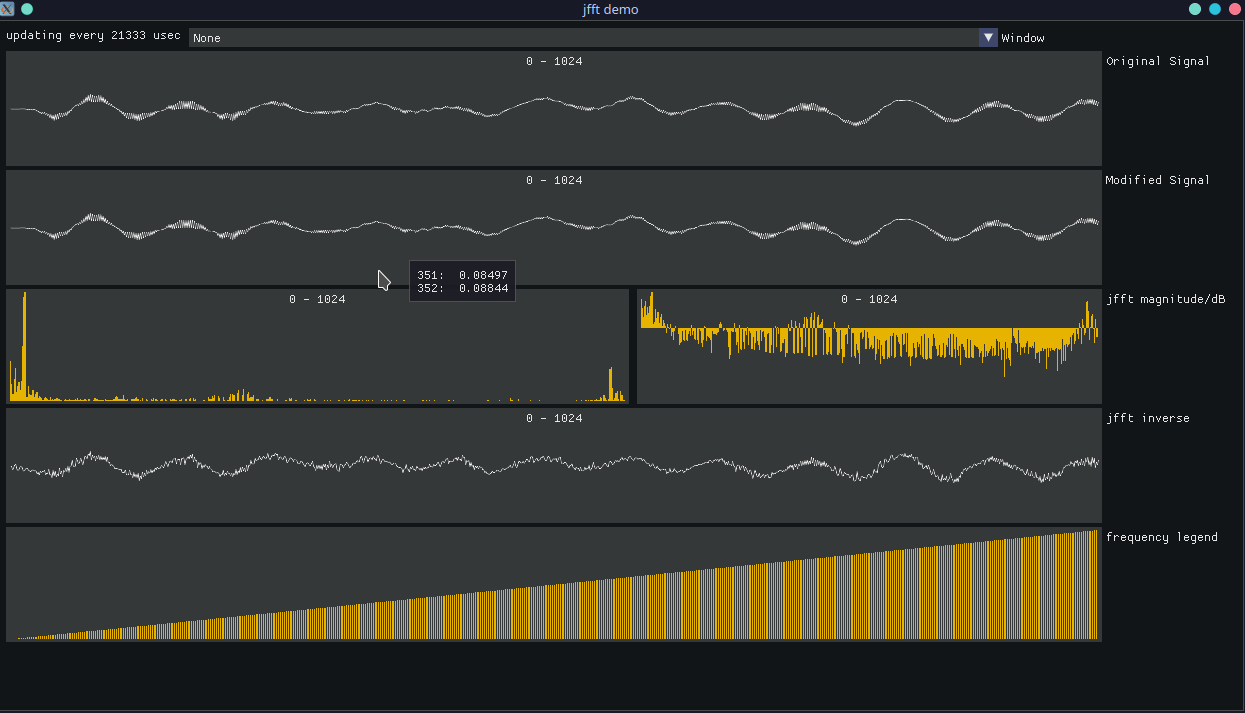| Feature | Description |
|---|---|
jfft |
Fast Fourier Transforms with various windowing functions |
jdsp_filter |
WIP Various filters including lowpass, highpass, bandstop, and bandpass |
jfft only processes real data sets at this time. No complex numbers. This means that instead of real/imaginary components we have sine/cosine.
jfft_create_transformer :: (signal_length: int, allocator: Allocator = temp) -> *jfft_transformer #must
Sets up the memory needed to perform FFTs on inputs of a specific length.
signal_lengthshould be a power of two for best performance, but the only real requirement is thatsignal_lengthis even. Internal memory can be reused byjfft_forwardandjfft_backward.
jfft_destroy_transformer :: (jfft: *jfft_transformer)
If you used something other than
tempas an allocator or you don't callreset_temporary_storagetoo often you can call this.
jfft_forward :: (jfft: *jfft_transformer, input: []float32)
Performs an FFT on a given input buffer and puts sine/cosine components .
inputshould match thesignal_lengthof the transformer. DC is in bin0. Bins1..N/2-1contain frequency bins. Nyquist starts at binN/2. Results can be fed intojfft_magnitude_transformorjfft_magnitude_dB_transformfor useful analytics.
jfft_forward_transform :: (input: []float32, allocator: Allocator = temp)
Creates
*jfft_transformerinternally. Same asjfft_forwardotherwise. Good as a one-off.
jfft_backward :: (jfft: *jfft_transformer, input: []float32)
Performs an inverse FFT on data returned from
jfft_forward. Floating point errors mean that the original signal may not be able to be recreated exactly depending on original signal.
jfft_backward_transform :: (input: []float32, allocator: Allocator = temp)
Creates
*jfft_transformerinternally. Same asjfft_backwardotherwise. Good as a one-off.
jfft_magnitude_transform :: (input: []float32)
Modifies input in-place. Converts results of
jfft_forwardto be magnitude data up toN/2due to Nyquist-Shannon sampling theorem. This means that an FFT can only provide useful info for frequency bins ofsample_rate / 2. Anything beyondN/2is imaginary or something (useful for reconstruction).
jfft_magnitude :: (input: []float32, allocator: Allocator = temp) -> []float32 #must
Same as
jfft_magnitude_transformbut it returns a new array without touching original data.
jfft_magnitude_db_transform :: (input: []float32)
Similar to
jfft_magnitude_transformexcept converts the firstN/2frequency bins to decibels.
jfft_magnitude_db :: (input: []float32, allocator: Allocator = temp) -> []float32 #must
Same as
jfft_magnitude_db_transformbut returns a new array without touching original data.
Modifications to the frequency-domain data from jfft_forward would require overlap-add for successful jfft_backward. The successful execution of Fourier synthesis from modified frequency-domain data is on the programmer and outside the scope of the API at this time.
Working on it!
Go into example and run jai example.jai -release. You should have an sdl2 library accessible somewhere in case the one in modules doesn't work for you for whatever reason.
Run it like ./example.
UP/DOWN will increase/decrease your chunk for FFT.
SPACE will pause the graphs at the current chunk.
LEFT/RIGHT will move to next/previous frame when paused.
K/L will decrease/increase the time betweeen chunks when unpaused.
Click the Window combo box at the top to see how different windows affect your input signal and FFT results.
